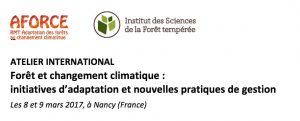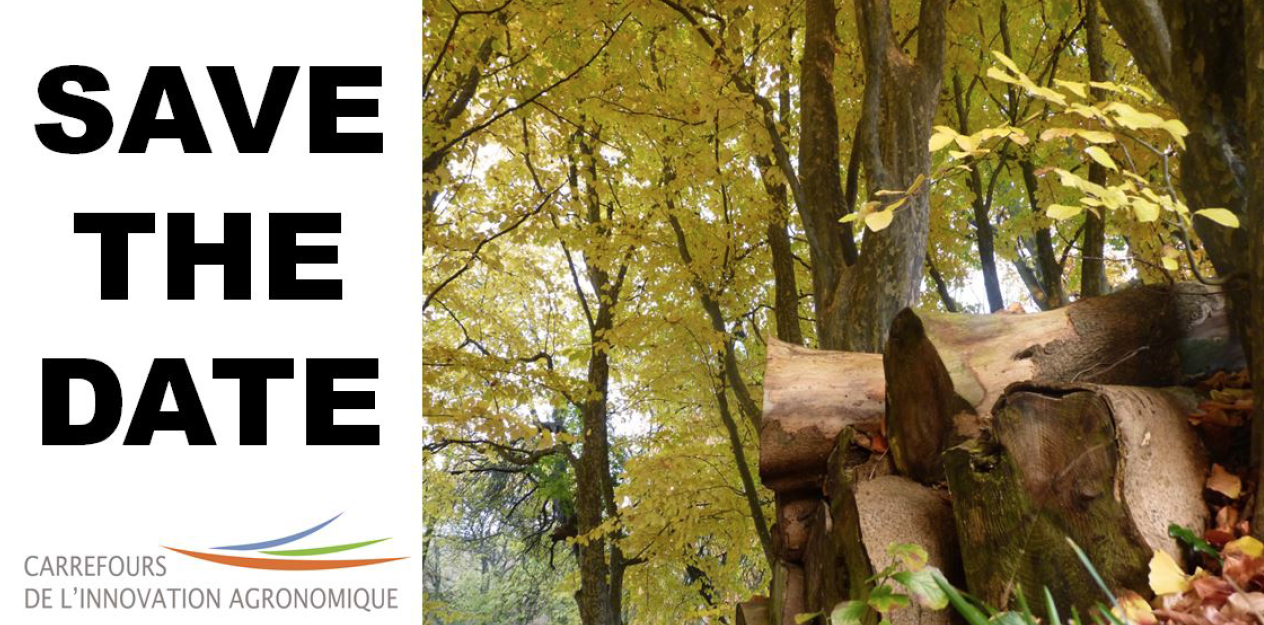The Call for Proposals RECOLTE (“Recherche ECOLe Thématique Excellence“) is opened for those willing to organize Theme Schools within Lorraine University Excellence (incl. LabEx ARBRE). More informations (in French): http://bit.ly/recolteLUE
Category Archives: Séminaires
Analyzing the growing stock expansion in French metropolitan forests
Ph.D. defense: Anaïs Denardou-Tisserand
“Changements du stock de bois sur pied des forêts françaises – Description, analyse et simulation sur des horizons temporels pluri-décennal (1975 – 2015) et séculaire à partir des données de l’inventaire forestier national et de statistiques anciennes”,
Friday 8 February 2019 at 9.00 am at Amphi Cuénot (Aquarium), Nancy.
Context. After centuries of decrease, the forest area of most developed countries increase, a phenomenon termed “forest transition”. While current increase in growing stock (GS) is greater than that in area, it remains far less studied. These changes are linked to major current issues. It is essential to assess these changes, to decipher their underlying causes, and to quantify them over the longer term in order to locate current forest resources on a broad trajectory and to anticipate their future dynamics. This thesis is dedicated to French metropolitan forests, which exhibit the most intensive changes in the growing stock in Europe, and relies on data from the French NFI program.
Objectives.
(1) Analyse forest areal, GS and GS density (GSD) changes and their spatio-temporal variations over 40 years (1975-2015). They were related to factors hypothesized to feature forest changes (geographical contexts, ownership and species composition). We screened for changes in the rate of expansion. The relationships between GS changes and some forest attributes (initial GS and GSD, recent forest area increase) were investigated.
(2) Uncover the processes of GS changes and to split the GS expansion magnitude across dynamically-homogeneous forest ensembles. The study was based on GS flux estimation (growth, ingrowth, mortality and harvest).
(3) Locate the actual GS expansion in a secular perspective. This analysis consisted in reconstructing the GS chronology since 1850. Levels of GS in 1892, 1908 and 1929 (associated to area of ancient statistics) were estimated using a conditional imputation approach for GSD estimation. Then, a holistic growing stock densification model was implemented to inquire the conditions required on densification patterns and magnitude to simulate the reconstituted GS chronology.
Results.
(1) Over 40 years, GS increases were three times faster than the areal ones, underlining the intensity of forest densification. No sign of saturation was found. Private forests, and mainly broadleaved ones, presented the greatest GS and GSD increases, suggesting the essential role of natural expansion and agricultural land abandonment. Regression models revealed the positive effect of initial GS and of recent areal increases on GS expansion.
(2) The analysis of GS expansion processes evidenced the low level of harvests in comparison to forest growth, and the contribution of recent forests to wood resource development. It led to identify four synthetic forest ensembles contributing to the expansion and of distinct dynamics, mainly composed of private forests.
(3) GS suggested a very low mean GSD at the beginning of the period (25 m3/ha) and a GS increase by almost +300% between 1892 and 2010, underlying the importance of this expansion. A convex growth model was required to simulate historical forest densification, attesting of a significant inertia in wood resource reconstitution after the forest transition, interpreted based on a gradual decrease in harvest rates for which indices were collected, or to a gradual recovery of site fertility. The analysis also suggested a distinct kinetics for GS densification in plantation forests.
Conclusions. These researches reveal the magnitude of GS expansion and the importance of its analysis across forest contexts. This ancient expansion does not present any current sign of saturation and constitute a persistent carbon sink which should not decrease in the next decades assuming similar contextual conditions. According to the process analysis of GS expansion, a significant fraction of the GS increases does not constitute readily available additional wood resources. Thus, future harvest intensification policies must be contextualized and evolving in time.
Keywords: forest expansion – forest transition – forest area – growing stock – volume – basal area – forest composition – forest management – land-use abandonment – plantations – harvest – national forest inventory

 To register, follow this link …
To register, follow this link …
Workshop BENCHAFOR
On October 2nd & 3rd, scientists from the ONF, INRA and DSF will discuss the current knowledge on the biology and ecology of cockchafers to explore novel options to limit the insect outbreaks and their detrimental impact on forest regenerations.
The common and forest Cockchafer are two beetle species well known for the damages they can inflict to forest ecosystems. Whereas the adults may occasion spectacular defoliations to adult trees, the larvae also feed on the roots of young trees causing severe mortality in forest regenerations, further impacting the whole forest management process. Eastern European countries had been facing recurrent infestations since the 1960’s; in France, cockchafer populations seem to have turned from endemic to epidemic in the last 10 years, with dramatic damages reported in young forest stands of Picardie and Northern Alsace. In Germany, chemical treatments proved to be efficient in reducing populations and subsequent damages but their use is now forbidden. A wide diversity of alternatives had been investigated in Europe, mainly based on biological control methods. To date, these studies did not produce results that could be developed and ultimately applied in everyday forest management.
Forest managers now question the opportunity of modifying forest ecosystem parameters that are critical for the different phases of the cockchafer lifecycle. Such actions are likely to produce short-term efficient methods with limited environmental impacts. This project is based on a benchmarking approach of the acquired scientific knowledge of cockchafer biology and of thetechnical experiences accumulated in the European countries that have been subjected to outbreaks in the last decades. We aim at investigating whether changes in silvicultural management are able to limit cockchafer population dynamics.
Our first objective is to establish a state-of-the-art review of the knowledge concerning the environmental factors which determine cockchafer outbreaks. Then, our second objective is to propose a protocol to describe stand cover structure and ground vegetation characteristics which determine cockchafer larval density. These two objectives will initiate national and international networking on the research for solutions to cockchafer damages to forests.
Finally, the proposed project will provide a framework of hypothesis for the research of ecological solutions to prevent cockchafer outbreaks. This innovative project is likely to initiate a technical and scientific strategy for the management crisis caused by cockchafer outbreaks.
Seminar: From molecules to the Globe

Dynamics of responses to canopy opening in beech trees
Ph.D. defense
Estelle Noyer “Réponses des perches de hêtre (Fagus sylvativa L.) à l’ouverture de la canopée : approche multidisciplinaire et multi-échelle.”
Friday 12 May at 9.30 am at AgroParisTech-Nancy (Amphithéâtre A).
Abstract: Opening of the canopy exhibits advantages (resources availability) but also new constraints (wind, higher evaporative demand). Rather well documented in saplings, response dynamics to canopy opening is less known in large trees. The thesis aims to identify the dynamics of responses to canopy opening in beech trees suppressed during long periods. Adopted approach is multi-disciplinary and multi-scale, based on a retrospective analysis of axial and radial growth, anatomy and biomechanical traits. For suppressed trees, the competition for light results in preferential allocation of biomass to axial growth in comparison with radial growth resulting in trees with high slenderness. Moreover, one third of suppressed trees are sagging. After the release, high slenderness presents a biomechanical risk: 15 from 36 trees are broken by the wind two years after the release. To increase their safety against the wind-break, trees reduce their axial growth during four years after the release and boost their radial growth reaching a stabilisation plateau after two years likely due to the size and resources limitations. Trees with lean angle higher than 6° up-right after the release. The tree ring hydraulic conductivity increases and stabilises after two year also. The dynamics of responses to canopy opening are therefore clearly trait dependent. Moreover, integrative approach highlighted the importance of size in the responses to canopy opening: while saplings adjust both wood tissue properties and tree geometry, large trees rely only on geometry adjustments.
Key-words : Fagus sylvatica, growth, biomechanics, anatomy, canopy opening, wood.
RMT AFORCE Workshop

CIAG — A forest an wood-based economy?
________________________________________________________
Thursday, 8 December 2016
Faculté des Sciences et Technologies
Vandoeuvre-lès-Nancy
Amphithéatre 8
The Center for Agronomic Innovation (Carrefour de l’Innovation Agronomique – CIAg) has gained recognition for offering research institutions (INRA and other research and development centers geared toward innovation) a valued platform for disseminating new projects and research results. Through a series of topic-specific forum discussions structured to foster productive and informative exchanges between researchers and actors in private sector development, the CIAg has become an important contributor at the crossroads of socio-economic changes currently taking place in industry and the French territories.
INRA has organized an upcoming CIAg forum dedicated to the emergence of a bio-based economy for forest and wood. This event will take place on December 8, 2016 at the Faculty of Science in Vandoeuvre-lès-Nancy. This CIAg forum will involve AgroParisTech Nancy and the University of Lorraine, with support from LabEx ARBRE.
While France is at the forefront in Europe in terms of wood production, trends in net trade balance have shown a decades long chronic deficit (currently close to 6 billion euros per year). In this context, the investment initiative Research Innovation 2025 proposes a series of innovation actions for the forest-wood industry which take into account not only new uses for wood and the role of ecosystem services, but also sets out a new vision towards developing research-innovation relations in this sector
In particular, newly developed concepts focused on the bioeconomy, involving the circular economy, and accounting for cascading value of products, by-products and non-linear interactions between sector actors, together offer a comprehensive analytical framework that could potentially breathe new life into the industry. The CIAg will aim to revisit and illustrate innovation issues related to forest resource management and wood uses.
Registration is free and is open through October.
For more information..
Jacques Monod Conference – Bacteria & Fungal Interactions
 Conférence Jacques Monod co-organized by l’INRA, CNRS and Labex ARBRE
Conférence Jacques Monod co-organized by l’INRA, CNRS and Labex ARBRE
Bacterial-fungal interactions: a federative field for fundamental and applied microbiology
7-11 December in Roscoff (Bretagne)
France
________________________________
Historically, the classical separation of microbiological research between bacteriologists and mycologists has led to the study of bacteria and fungi in gnotobiotic settings. This compartmentalization has overlooked the fact that in many environments bacteria and fungi coexist and interact, forming physically and metabolically interdependent consortia that harbour distinct properties from their single components. These mixed consortia are of central practical importance in an exceptionally diverse variety of fields including agriculture, forestry, environmental and cultural heritage protections, food processing, biotechnology, and medicine.
By not focusing exclusively on one area of application, the Jacques Monod Conferences seek to generate a novel unifying perspective on BFIs that enables the identification fundamental themes, mechanisms and areas of mutual interest.



